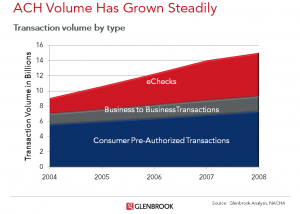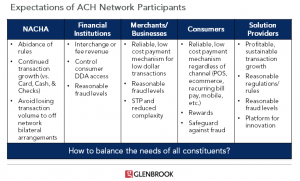Editor’s Note: This is one of a pair of ACH commentaries that we are publishing today on Payments Views. Be sure to also read Carol Coye Benson’s post “ACH: Big Questions for the Biggest Network” based on her recent interview with NACHA CEO Jan Estep.
I recently presented to TAWPI’s Payments Capture and Clearing (PCC) Council and had 15 min to address The Future of ACH. Needless to say, I was only able to cover a couple key themes and answer a few questions. So here is an expanded version of my thoughts on this topic:
The enduring allure of ACH is its ubiquity and low cost. All banks are connected and transactions are relatively inexpensive for banks and businesses to process. In addition, the ACH network has been a friend and enabler of alterative payments, inadvertently (at first) or intentionally fostering innovation (later).
Today, after nearly a decade of steady growth, the momentum is decreasing. The ACH network is at a crossroads and key stakeholders are vocally calling for change (e.g. the Federal Reserve’s announcement of same-day settlement) or pursuing alternate strategies (Wells Fargo and BofA’s partnership to form Pariter).
The ACH must proactively address four key trends in order to remain relevant and continue to grow:
1) Shifting volume and new growth drivers – Roughly half of ACH transactions are payments to/from consumers initiated by businesses. Many are direct deposit of payroll and others are for recurring bill payments. They’ve steadily increased in number over the years, but are not a significant growth area (see blue area at bottom of Figure 1 below). As the economy slowly recovers it is not expected to achieve the same growth rates we’ve enjoyed in the last few years, and ACH transaction volume growth has decelerated accordingly.
Transactions from one business to another (B2B) remain a minority and have grown only modestly over time (gray area in Figure 1). Yet there is pent up demand for useful business payment solutions that carry data as well as dollars; I believe this is a key opportunity for ACH (more on that in a moment…).
eChecks have been the primary growth engine for ACH in recent years (red area in Figure 1). Check conversion eChecks, most notably the hockey-stick adoption of ARC, drove new ACH transaction volume in the post Check 21 era. Today, however, native electronic eCheck transactions such as WEB, which is used for transactions initiated online – for example by PayPal or for bill payments over the internet – are growing more quickly than check conversion transaction types (see Figure 2). ARC will remain a key ACH transaction type, contributing sizable volume, but is no longer a significant driver of growth. The other eCheck ACH transactions, POP and BOC, are discrete solutions for converting checks at the point of sale, or a retailer’s back office, but are niche solutions and unlikely to drive growth the way ARC did.
Figure 1: NACHA Transaction Volume by Segment
Figure 2: eCheck Transaction Volume
2) ACH fosters payment innovation – Here at Glenbrook we follow, encourage, and are occasionally mystified, by payment innovation. So called ‘alternative payments’ are at the core of our practice. Many of the new payment schemes use the ACH as a platform for innovation (PayPal being the most well-known, but they are an incumbent now, not an upstart innovator). Everyday it seems that there are new solutions emerging in the ecommerce, point of sale (POS), and mobile arenas that also rely on ACH.
ACH rules have been modified over time and new transaction types created in order to address the changing payments landscape. And in recent years, NACHA has not only encouraged innovation, but has participated as an innovator. The network has fostered its own payment mechanisms: EBIDS and Secure Vault Payments. By encouraging – or even leading – innovation the ACH network can retain a central role in defining the future of the payments industry.
3) Globalization increases demand for International transactions – Demand for cross border transactions, whether initiated by companies or consumers, is growing. Business of all sizes are now transacting globally, often within their region but also across regions. The Global recession has lessened demand, but this macroeconomic trend that will not go away. In the meantime, explosive growth for global remittance payments from foreign workers to their families at home, while abated by the softened economy, is still a huge market (estimated to be $456 billion by 2010). Nonbank money transfer solutions and private networks have long dominated the global remittance market. However, the payments industry is just now defining new solutions – many leveraging mobile. The US is a primary source of outbound global remittance payments and the ACH network could be a primary origination method for these transactions.
ACH, by its nature, is a domestic payment solution, but as of September 18, 2009 International transactions (to or from the US, via the ACH network) will have their own transaction code IAT. While this change was largely motivated by regulatory oversight it should lead to innovative new product. Yet, true interoperability between the US ACH and other low value, high volume payment networks worldwide will take many years to come to fruitition. Efforts are underway, most notably InternationalPaymentsFramework.org, and adoption of the XML ISO 200022 standard would be a key step in the right direction. NACHA in conjunction with the Fed should continue efforts to explore global payment interoperability in order to address the payment needs of our increasingly Global economy.
4) Competing with card networks to electronify business transactions – Business to business (B2B) transactions remain stubbornly paper. Businesses continue to initiate nearly 76% of their transactions as paper checks. The ACH network supports detailed remittance data via CTX but only a small subset of business transactions carry the data. Instead, companies send payments via ACH and remittance data via email, fax, EDI, web portals, etc. Until the data and dollars arrive together, in a format that can be easily absorbed and interpreted by accounting packages and ERP systems, businesses will continue to rely on paper checks, sending remittance details in the same envelope, to be processed via lockbox or hand-keyed by receivables clerks.
Companies have indicated that they would gladly pay for a truly robust solution that addressed the A/R cash application headache (Source: NACHA Research). Over the last couple years NACHA has focused on exploring small business payment solutions, an effort that we at Glenbrook applaud, as each large business exchanges transactions with a long tail of suppliers. Supply chain solutions that are focused on large trading partners and their suppliers exist, and work well for tightly knit financial supply chains, but are not going to address the remaining 74% of transactions that are still made with checks.
[B2B payments are the focus of my consulting practice. For more on B2B Payment Myths and Realities, read this post by my colleague Carol Coye Benson and this recap of our recent B2B Payment Workshop in NYC.]
5) Same day ACH clearing In March the Federal Reserve announced that select ACH debit transactions will clear on a same day basis. The rationale provided by the Fed is that the change in clearing timing will make ACH more competitive – particularly with check image exchange transactions. An increasing amount of ACH transaction volume is exchanged outside the ACH network via bilateral arrangements between banks, enabling faster settlement and lower fees. The change is voluntary and goes into effect 2nd Quarter 2010. It only impacts those transactions that are received by 2:00 pm. The Fed is one of two ACH switches (the other is operated by EPN).
The ACH community is divided as to whether same day clearing is beneficial. An alternate proposal enables receiving banks to retain float on pending transactions by memo posting ACH received by 8:00 PM and clearing them the following day.
In my humble opinion, the same day payment settlement debate is a distraction. It may make sense for a subset of transactions – expedited bill payments, urgent business payments, perhaps a same day clearing transaction specifically for mobile P2P transfers – but changes necessary to support ACH network wide same-day settlement would be costly for all parties and there is no clear benefit. (More about Same Day ACH in my colleague Carol Coye Benson’s post based on her interview with NACHA CEO Jan Estep).
The Future of ACH
The ACH community should be focused on leveraging its key assets – ubiquity and low cost – to provide true value-add services that will attract an ever increasing number of native electronic payments. International and B2B payments are vast opportunities that the ACH network can effectively address and charge a modest premium for. But concentrated effort is necessary. Otherwise alternate networks (e.g. Pariter) or alternate payment methods (Wires) or payment schemes (card networks) will address these needs sooner, and relegate the ACH network to being an underlying network for innovation taking place elsewhere.
In determining its next steps, the ACH network needs to balance the expectations and needs of its constituents (see Figure 3). By providing value-add services, reliably, for reasonable prices, with appropriate safeguards to protect consumers and businesses from fraud and bank and processers the ACH network can insure its future as a key enabler of electronic payments, domestically as well as to/from global counterparties.
Figure 3: ACH Network Participants have varying expectations
What are your thoughts on the future of the ACH network?
Let us know in the comments.




